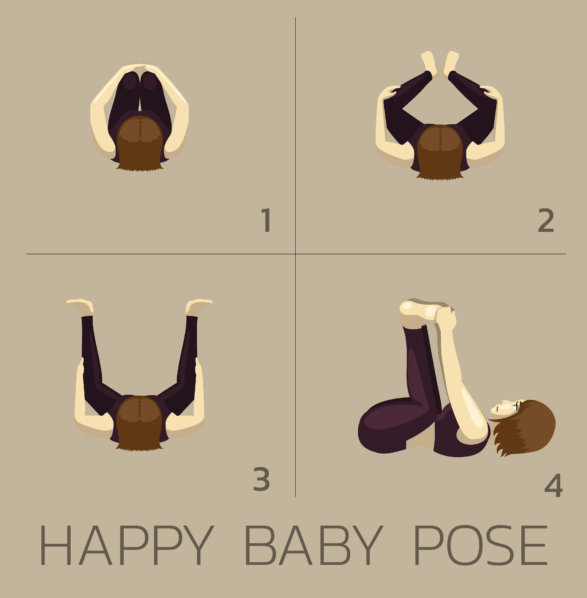Ah, the elusive good night’s sleep…. Learn and practice the top 7 yoga poses for better sleep with easy-to-follow video tutorials!
If you struggle to stay awake in the afternoon, have difficulty concentrating, find yourself yawning, or are lacking motivation – you may want to look at the quality of your sleep. The average sleep cycle lasts around 90 minutes and we need four to six cycles each night to feel our best. Each cycle comprises four stages; three stages with non-rapid eye movement and one stage with rapid eye movement (REM), which is the stage when we dream.
We all know that irritable feeling the day after a short, disrupted sleep, but improving your mood is just one of the many important benefits of a good night’s sleep. The CDC recommends seven to nine hours of sleep for adults aged 19-64 years and seven to eight hours for those over 65. If you are falling short of this you may be missing out on these other importation benefits:
- Boosting your immune system
- Improving your mood
- Decreasing your stress
- Improving memory function
- Repairing tissue and muscle function
- Emotional processing
Our quality of sleep is one of the markers of our quality of life. So what steps can we take to improve the quality of our sleep? Here are three efficient steps we can take right now, and with consistency over a short amount of time, will show results.
#1 Be consistent with your bedtime and wake time.
Ok, so you’re all grown up but surprise, surprise, you should still have a ‘bedtime.’ As stated by Sleep Foundation, ‘Circadian rhythms are 24-hour cycles that are part of the body’s internal clock, running in the background to carry out essential functions and processes. One of the most important and well-known circadian rhythms is the sleep-wake cycle.’ When we are consistent with our sleep/wake cycle, we are working in harmony with our natural rhythms.
#2 Turn off electronic devices at least one hour before bedtime.
LED lights, smartphones, TVs, computer screens, tablets…. blue light is everywhere!! Who cares? Your sleep cycle does. Blue light, which is emitted from all your devices stimulates the part of the brain that make you feel awake and alert. Blue light suppresses your body’s release of melatonin, the sleep hormone.
#3 Incorporate restorative yoga poses before bedtime. Yoga is a multi-faceted discipline. Depending on the type of poses you choose you can use yoga for strength, yoga for balance, yoga for flexibility, and yoga for sleep, to name just a few. Here are 7 yoga postures for sleep that will take you from wide-eyed to shut-eyed in no time.
#1 Yoga Pose for Better Sleep – Child’s Pose
Child’s pose aka Balasana is a foundational pose that is used in just about every yoga practice. If you are looking for yoga poses for sleep this is definitely one to add to your nighttime practice. It has the feeling of coming home, of overall release, of ultimate surrender. In addition to opening the lower back and easing tightness in the hips, Child’s pose helps to quiet the mind, preparing you for a great night’s sleep.
Rudy Mettia demonstrates proper alignment for Child’s pose.
#2 Yoga Pose to Stretch Entire Body – Yogi Squat
For those of us who are sitting at our jobs all day, spine compression and tight hips are real. Yogi Squat aka Garland pose aka Malasana stretches the entire body, from feet to shoulders, and in turn, relaxes and prepares the body for sleep. Just like Happy Baby pose, Yogi Squat comes naturally to babies and children. Yes, nature knows best.
#3 Yoga Pose for Relaxation – Plow Pose
Plow pose aka Halasana is a relaxing pose, that relieves stress and tension. This posture stretches the length of the backside of the body, once unfurled the body will be primed for drifting off into dreamland. Plow pose is a stress-buster that soothes the nervous system, mind, and body.
#4 Yoga Pose to Calm the Mind – Happy Baby
Happy Baby pose aka Ananda Balasana is not just for babies! It reduces low back pain, realigns and stretches the spine, lowers the heart rate, and calms nervous energy. Happy Baby pose calms the mind and relieves stress.

#5 Yoga Pose for Better Sleep – Seated Forward Fold
Seated Forward Fold is a relaxing, stress-buster that soothes the nervous system, mind, and body. Opening the spinal column creates space for the body/mind channel to communicate more effectively. Folding poses are ideal for sleep preparation because, in these poses, space is created for increased circulation to the spinal cord, which sends calming signals to the brain. And who doesn’t love that?
#6 Yoga Pose for Better Sleep – Corpse Pose
Many yoga practices begin with Child’s pose and finish with Corpse pose aka Savasana. And no one can deny that Savasana feeling. We recommend you practice the above list of poses outside the bed, perhaps on the bedroom floor, then save Corpse pose for last after you’ve laid down in bed.
#7 Yoga Nidra for Deep Relaxation
Yoga Nidra is not considered a yoga pose, but more of a yoga practice, so how could we not include it when discussing techniques for sleep? Yoga Nidra is a guided meditation technique where practitioners lay on their backs while being guided to focus on relaxing the body and mind, one specific area at a time, moving through the entire body. You might incorporate Yoga Nidra for sleep or Yoga Nidra for relaxation (or both!) into your list of favorite classes.
Interested in more information on the study of sleep? Check out Dr. Matt Walker, Professor of Neuroscience and Psychology at the University of California, Berkeley, and the founder and director of the Center for Human Sleep Science, and listen to his podcast.
Sweet dreamzzzzz


Write Your Comment
Leave a comment